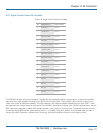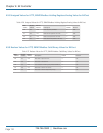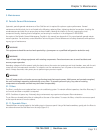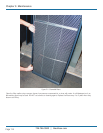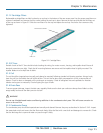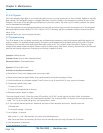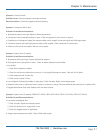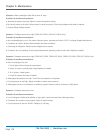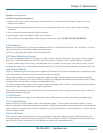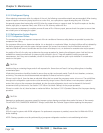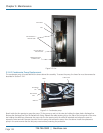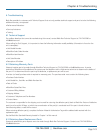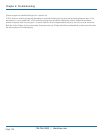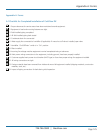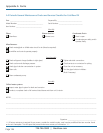
724-746-5500 | blackbox.com
724-746-5500 | blackbox.com
Page 119
Chapter 5: Maintenance
Symptom: Noisy compressor.
Probable Causes/Recommendations:
a. Expansion valve stuck in open position (abnormally cold suction line). Ensure feeder bulb is tight on suction line. Check
operation and superheat.
b. Broken compressor valve (compressor knocking, suction pressure rises faster than 2 lb./min. after shutdown). Replace
compressor.
c. Worn or scarred compressor bearings. Replace compressor.
d. Liquid slugging. System overcharged. Reclaim excess refrigerant.
e. Scroll compressor not properly phased. Phase correctly at main power source. DO NOT REWIRE COMPRESSOR.
5.3 Field Service
Repairs must be performed by a journeyman refrigeration mechanic or air-conditioning technician. Turn off power to unit at the
main power disconnect switch before attempting to make repairs.
NOTE: Do not attempt to make repairs without the proper tools.
5.3.1 Water–Water/Glycol System
If the water or water/glycol system isn’t cooling or if cooling is reduced, check for fluid leaks in the system. Check for clogged
water lines. If filters are installed in the fluid lines, check the condition of the filters. Clean or replace the filters if necessary.
In situations where scaling could be heavy, untreated water in the unit cooling coils may cause, over a period of time, a loss of
heat exchange capacity from a mineral deposit build-up inside the coil. Only a qualified service mechanic should clean dirty coils.
Leak Detection/Repair
A leak in a fluid cooling system will usually form a puddle of fluid beneath the unit that can be easily seen. Visually trace the leak
up from the puddle to the area on the unit where fluid may be seen dripping.
When a leak is detected, turn off the fluid supply before attempting repairs. Adjacent piping must be thoroughly cleaned by
removing all paint, dirt and oily film. Use a wire brush, sandcloth, or sandpaper and wipe the area with clean, dry cloths. Protect
nearby parts from heat damage by wrapping with watersoaked cloths.
For copper-to-copper (piping) repairs, use a phosphorus copper brazing alloy with 15% silver. Use general-purpose silver brazing
alloy with 45% silver for copper-to-brass or copper-to steel repairs.
When repairs are completed, remove all traces of flux and flush the system. After any repair, pressurize the system to check for
leaks before recharging the system.
5.3.2 DX System
You might need to perform repairs on the refrigeration system. If field repairs are necessary, the following procedures apply:
5.3.2.1 Leak Detection
Several methods can be used to detect a leak in the refrigeration system. The most modern and easiest method is to use an
electronic leak detector. Follow the manufacturer’s directions to quickly locate any leak. A second method is to use soap bubbles.
Apply a solution of soapy water with a brush or sponge to the joints and connections in the refrigeration lines. A leak in the lines
will cause bubbles to form.
5.3.2.2 Leak Repair
When a leak is located, properly reclaim the remaining refrigerant charge before beginning repairs. Adjacent piping must be
thoroughly cleaned by removing all paint, dirt, and oily film. Use a wire brush, sandcloth, or sandpaper and wipe the area with
clean, dry cloths. Protect nearby parts from heat damage by wrapping with water-soaked cloths.



